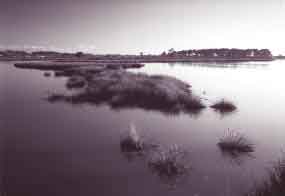| Our Environment: Issue 26 Autumn 2001 |
 A green
edge to be created around the western side of the Avon-Heathcote Estuary is designed to
protect and enhance one of Christchurch’s most important environmental assets.
A green
edge to be created around the western side of the Avon-Heathcote Estuary is designed to
protect and enhance one of Christchurch’s most important environmental assets.
The proposal, which includes Linwood Paddocks, Bexley Reserve and the oxidation ponds, is associated with the City Council’s 15 year wastewater programme to discharge a much higher quality of wastewater into the estuary.
The Green Edge has the potential not only to protect and enhance existing habitats but to create new “natural” open space areas, says planner Adele Scoon. These will have wideranging benefits for the area’s ecology, recreation, heritage, education and landscape values.
 Situated
only a few kilometres from our city centre, the estuary is unparalleled among New Zealand
estuaries in supporting such a large and varied wildlife population, according to a recent
Council report. Despite its importance natural coastal marshlands, forests, dunelands and
wetlands have been degraded by roads, housing and construction of the oxidation ponds.
“Introduced trees, garden plants and exotic grasses have replaced native vegetation
and the soft estuary shoreline has been replaced with hard edges and unnatural and often
unsightly structures,” the report says.
Situated
only a few kilometres from our city centre, the estuary is unparalleled among New Zealand
estuaries in supporting such a large and varied wildlife population, according to a recent
Council report. Despite its importance natural coastal marshlands, forests, dunelands and
wetlands have been degraded by roads, housing and construction of the oxidation ponds.
“Introduced trees, garden plants and exotic grasses have replaced native vegetation
and the soft estuary shoreline has been replaced with hard edges and unnatural and often
unsightly structures,” the report says.
Development of experimental natural treatment of wastewater and stormwater in engineered wetlands is planned in part of Linwood Paddocks. Because of the relatively small area of land available the scheme will trial localised solutions to water treatment.
Re-establishment of saline and brackish ecosystems of saltmarsh and ribbonwood, establishment of coastal forest and enhancement of roosting and breeding sites is also planned in the paddocks.
Plans include reconfiguration and restoration of the oxidation ponds and surrounding area to a sand dune and wetland mosaic, and retention of islands as a vital breeding habitat.
 Where possible,
hardfill creating artificial hard edges along parts of the western shoreline will be
replaced with more natural graded banks and saltmarsh species. Bexley Reserve, to be
developed into an attractive recreation area, will be a buffer between the city’s
suburban edge and natural areas such as Te Huingi Manu Wildlife Reserve and the estuary.
Where possible,
hardfill creating artificial hard edges along parts of the western shoreline will be
replaced with more natural graded banks and saltmarsh species. Bexley Reserve, to be
developed into an attractive recreation area, will be a buffer between the city’s
suburban edge and natural areas such as Te Huingi Manu Wildlife Reserve and the estuary.
Estimated to cost $14 million, the plan will be implemented over the next 15 years with ongoing maintenance costs of about $300,000 a year.
Jennie Hamilton
| Our Environment Index |